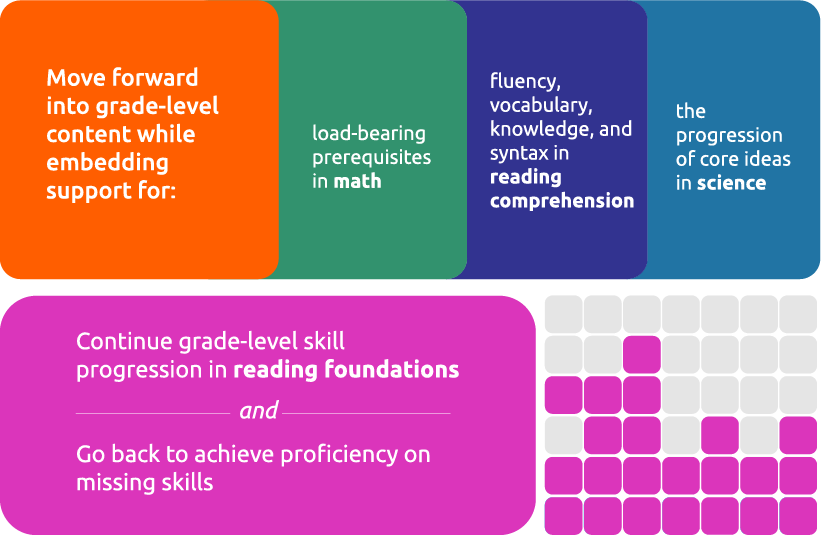The best of what we know about addressing unfinished learning
This post is part of our series on addressing unfinished learning. Learn more and download our toolkit here.
I always love planning for the next school year. With the prior year in the rear-view mirror, we get to process lessons learned and redress past mistakes in our goals and plans. As I talk with teachers this summer, planning is bringing up lots of anxieties. Educators always know they will have as many personalities as they have students, but they are feeling like the range of needs will be even broader in the year ahead. The question I hear most often is, “How can I be prepared to meet the wide range of unfinished learning needs?”
A few months ago, I shared with you some of my fears about the unfolding conversations about unfinished learning. We then toured concrete examples in math, science, reading foundations, and reading comprehension—based on the lessons from our Rethinking Intervention interviews as well as the on-the-ground work we did this past year with partners.
We are pleased to share all of the tools we compiled in one place: our toolkit for addressing unfinished learning. You’ll find an overview of content-specific guidelines in this five-pager; the complete toolkit contains practical tools, templates, and recommendations for addressing widespread unfinished learning challenges.
As I reflect across content examples, I see four big takeaways:
- Across subjects and grades, what happens in core academic classes (Tier I instruction) will play a big role in what students learn. While conversations about intervention are important, kids’ learning will be shaped and, in many ways, governed by what happens in core classes. To address unfinished learning in math, math class will matter more than intervention blocks or after-school support because the core classwork will set the bar and focus.
- Addressing unfinished learning well will require teachers to slow down on the big stuff, NOT try to race through material in an effort to cover more. Not all standards matter equally to future learning and teachers will need to be able to focus their energy and time preparing to meet a range of needs on those topics. Teachers will help students go further if they go deep on the standards and texts that matter most, rather than creating a “catch up” frenzy.
- Each content area is different; we can handle the complexity. To summarize the content-based approaches in a single graphic, here is what we found:

Unfinished learning summary graphic
- Giving teachers time and support for good UNIT planning will give leaders the most return on investment. Supporting unfinished learning requires that teachers integrate their understanding of both context and content. There is no technology that can do the job; the task will always require good human judgement. The decisions become more tangible and manageable within a given unit (e.g., What prerequisite matters most for this set of standards or texts? How will I know if my students have those prerequisites? How can I use time across this group of lessons?). The key steps are replicable but they take time to work through in the context of each unit.
In sum, addressing unfinished learning is entirely possible. Supporting unfinished learning well requires attention to both content- and context-specific variables; it is a non-simplifiable equation. We have to understand the content taught and what students are bringing to that content to know what to do; once we do, the decision trees are clear and replicable.
We will be walking through these tools on a couple of upcoming webinars:
I hope you’ll download the full toolkit, share it and the webinar details with those you know who might benefit, and let me know if there are ways we can work together to support sharing and learning. We know that many others have put forth powerful tools to address unfinished learning, and we have linked to other resources throughout to make it easy for educators to find these in one place. If there are tools and resources we missed, let us know and we will share them. #StrongerTogether
Thanks for taking the weedy journey with me. Here’s hoping the lessons can inform action in the very important school year to come.


